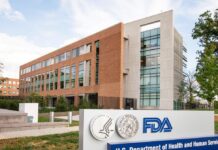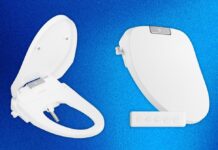The campaign
WHAT PANDEMIC?: President Trump’s speech last night on the White House South Lawn was a reflection of the struggles his flagging campaign is facing in the wake of the coronavirus pandemic.
Most of the 1,500 supporters who gathered to celebrate Trump’s renomination did not receive rapid coronavirus tests, did not wear face masks and were seated closer than six feet apart.
Speakers throughout the campaign-rally like program praised the president for his handling of the pandemic that’s killed 177,000 Americans and tried to frame the virus as a thing of the past — even as medical experts warned the mass gathering could trigger community spread.
- “The program also projected the image to millions watching on television that a president whose public approval ratings have fallen over widespread disapproval of his handling of the pandemic has returned to business as usual, even if most Americans have not,” our colleagues David Nakamura and Josh Dawsey write.
Trump and his lineup of speakers blamed Joe Biden and the Democratic Party for the country’s current socioeconomic problems, bragged of an economy that has cratered as the virus has sent millions to the “brink of financial ruin,” and propagated falsehoods in defense of his management of the pandemic — even as the number of deaths and spread of cases in the country outpaces every other nation.
- “America has tested more than every country in Europe put together, and more than every nation in the Western Hemisphere combined. We have conducted 40 million more tests than the next closest nation,” Trump claimed, providing a misleading indicator on raw numbers of tests compared to those per capita.
- “Two attendees said in interviews that they were not offered tests and were not even put through a more basic screening, such as being questioned whether they had any symptoms, such as coughs, or taking their temperature. They spoke on the condition of anonymity to talk frankly,” per David and Josh.
- “A White House official said it was logistically unfeasible to test such a large number of people.”
- Ahead of Trump’s remarks, the White House announced a $760 million deal with Abbott Laboratories to provide 150 million rapid coronavirus tests, Lenny Bernstein and Seung Min Kim report.
Thursday’s alternative reality was the cherry on top of a week in which “Trump and his allies used the unfiltered platform of a national political convention to paint a portrait of two Americas that do not exist,” our colleague Toluse Olorunnipa writes.
- “In one — a misrepresentation of life under Trump — the coronavirus has been conquered by presidential leadership, the economy is at its pre-pandemic levels, troops are returning home, and the president is an empathetic figure who supports immigration and would never stoke the nation’s racial grievances.”
- “In the other — a hypothetical preview of a Joe Biden presidency that mischaracterizes many of his proposals — police are defunded, taxes are increased, infanticide is legal, suburbs are abolished and cities burn as violence spreads nationwide.”
- “While all political confabs involve some level of spin and revisionism, the Republican National Convention this year has stood out for its brazen defiance of facts, ethical guidelines and tradition, according to experts on propaganda and misinformation,” per Toluse.
Trump repeatedly drove home his claim that America wouldn’t be safe from the “anarchy” and “chaos” riving “Democrat-led” cities protesting police brutality in the wake of police killings of Black people. But that argument was also cast in a confusing and sometimes contradictory manner.
- “And extending a tension that defined much of the week, Mr. Trump again drove an inconsistent message on criminal justice, bragging of his own efforts to make the system more merciful while claiming that Democrats’ support for more lenient policies would result in hordes of criminals pouring ‘onto your streets and into your neighborhoods,’” the New York Times’s Alexander Burns and Maggie Haberman.
- “The more chaos and anarchy and vandalism and violence reigns,” outgoing White House aide Kellyanne Conway said on Fox News on Wednesday night, “the better it is for the very clear choice on who’s best on public safety and law and order.”
- “The RNC seems to have put the emphasis on a tried-and-tested weapon to try to unite support — leveraging fear in fearful times,” Emma Briant, a professor at Bard College who studies propaganda and political communication, told Toluse. “If one doesn’t have truth on one’s side, shouting loudly with emotion can certainly work.”
Trump’s own agenda for the next four years, which he has struggled to articulate, was no more clear by the end of his speech. In an interview with the New York Times’s Peter Baker on Wednesday, “Trump rattled off a list of what he has done and would continue, like increasing military spending, cutting taxes, eliminating regulations, reinforcing the border and appointing conservative judges.”
- “But so I think, I think it would be, I think it would be very, very, I think we’d have a very, very solid, we would continue what we’re doing, we’d solidify what we’ve done and we have other things on our plate that we want to get done,” he said.
The policies
OMISSION: Trump kicked off convention week in Charlotte by railing against mail-in voting, which he claims will be rife with fraud as states expand the practice to accommodate voters who don’t want to cast in-person ballots because of the pandemic.
Notably missing from Trump’s big speech on Thursday night was any mention of mail-in voting, perhaps because Republican strategists have warned such attacks could undermine the GOP’s own efforts.
Counterprogramming: Voting and disinformation experts have snapped into action, starting to warning American voters that Nov. 3 election will be an election unlike any other. The Defending Digital Democracy Project at Harvard Kennedy School’s Belfer Center believes the media plays a crucial role in setting realistic expectations about the election.
- D3P, shorthand for the program, is assembling an “Election Influence Operations Playbook” to provide election officials with verified resources on threats; an introduction to understanding election influence operations; and “recommendations for reporting, responding and countering mis and disinformation incidents around elections.”
- The group has built out a national training corps for state election officials to teach them how to maintain citizen confidence in elections and provide people with verified voting resources.
D3P officials say because of the potential for a large increase in mail-in balloting, the media should prepare voters for a possibly major delay in getting results that typically come on election night, said the group’s Anna Sakellariadis:
- “If our country enters Nov. 3 expecting we will have unofficial election results announced on that night — and we almost certainly won’t — that leaves open the door for a lot of mis and disinformation to spread about our election,” she said.
- In the past, the number of absentee ballots has been less than the margin of victory, “but when you have a significant increase in absentee ballots, as we expect this year, and especially when we don’t have good precedents to estimate how many voters will choose to vote by mail or in person during this pandemic, that is no longer the case,” Sakellariadis explained.
A poll conducted by the Knight Foundation found a majority of young people, for example, are likely to doubt the results of the election — especially “if it’s not administered well.” Seventy-four percent of young people “will have major or minor doubts about the fairness of the election if it takes weeks to count.”
- D3P wants voters to remember that democracy is working even if there isn’t a winner declared on election night: “Without knowing on Nov, 3 whether the margin of victory from in-person voting is greater than the number of absentee ballots cast, it will be almost impossible to confidently project a winner on that night,” per Sakellariadis. “And, in this case, learning results at a later date does not mean that our system is malfunctioning; it means that ensuring an accurate and secure count will take longer than in past years.”
- “To the best of their ability it’s important for the media to accurately describe what to expect from this election well in advance of issues occurring,” Sakellariadis added. “So for instance, we recommend that, rather than referring to ‘election night’ in election coverage, reporters talk about ‘election week’ or ‘election month.’ Otherwise it creates an opening for audiences to believe that something went wrong if unofficial results are not conclusive on November 3rd.”
A perhaps even more urgent task: Ensuring voters understand how to properly cast their ballots by mail where targeted efforts are spiking to fan flagrant falsehoods about the practice.
For example: “Officials launched an investigation Thursday into what they said was an erroneous, racist robocall aimed at discouraging voters in battleground states from casting their ballots by mail,” The Post’s Meryl Kornfield reports.
- Voters in Democratic-leaning Detroit, Pittsburgh, and Philadelphia received a recorded message from “a woman who says she works for ‘Project 1599,’ founded by the right-wing operatives Jacob Wohl and Jack Burkman, and falsely warns that personal information of those who vote by mail will be shared with police tracking down warrants and credit card companies collecting outstanding debt, according to recordings of the call reviewed by The Washington Post.”
Michigan Secretary of State Jocelyn Benson (D) and Attorney General Dana Nessel (D) released statements rebutting the misinformation:
- “This is an unconscionable, indefensible, blatant attempt to lie to citizens about their right to vote,” Benson wrote. “The call preys on voters’ fear and mistrust of the criminal justice system — at a moment of historic reckoning and confrontation of systemic racism and the generational trauma that results — and twists it into a fabricated threat in order to discourage people from voting.”
- “Disinformation targeting elections, and resulting misinformation, highlight elements of how elections run,” Maria Barsallo Lynch, DP3’s executive director, told Power Up. “As voters, we should be prepared to seek and verify information with official sources of information in our communities ahead of, during or after election day.”
The stakes are high in key battleground states as millions of Americans plan to vote by mail this fall. Our colleague Elise Viebeck reports on critical steps voters should take to properly cast their ballot.
“More than 534,000 mail ballots were rejected during primaries across 23 states this year — nearly a quarter in key battlegrounds for the fall — illustrating how missed delivery deadlines, inadvertent mistakes and uneven enforcement of the rules could disenfranchise voters and affect the outcome of the presidential election,” Elise reported earlier this week.
- “The rates of rejection, which in some states exceeded those of other recent elections, could make a difference in the fall if the White House contest is decided by a close margin, as it was in 2016, when Donald Trump won Michigan, Pennsylvania and Wisconsin by roughly 80,000 votes.”
There are some key steps Americans should take to cast a mail ballot, per Elise’s helpful guide to prevent your ballot from being rejected. It’s a process that can be complicated compared to in-person voting as “it involves more steps and more opportunities for problems – including some outside the voter’s control.”
- “If you need to request your ballot, do it early.”
- “Read the instructions, and seek clarification from election officials if you are confused.”
- “If you must sign your name, learn about signature matching.”
- “Avoid stray marks, tears and other accidental flubs that could disqualify your ballot.”
- “Return your ballot as soon as possible. If you do not want to use the mail, there might be other options.”
- “Seek reliable information about the process from election officials.”
At the White House
CONVENTIONAL WISDOM: What else happened on the final night.
Protests raged outside the White House: “Hundreds of protesters chanted, marched and played music near the White House on Thursday as President Trump spoke on the final night of the Republican National Convention — a loud and often raucous rejoinder to a leader they say has divided the country and supported racist policies and practices,” Antonio Olivo, Fenit Nirappil, Justin Wm. Moyer and Joe Heim report.
Demonstrations continued after Trump’s speech ended: “A group of demonstrators shouted at supporters of the president as they left the White House, including Sen. Rand Paul (R-Ky.), who had to be escorted to a nearby hotel by police. Officers sprayed a chemical irritant at the protesters.”
All the president’s falsehoods: “Trump ended the Republican National Convention with a tidal wave of tall tales, false claims and revisionist history. Here are 23 claims by the president that caught our attention, along with seven claims by speakers earlier in the evening. As is our practice, we do not award Pinocchios for a roundup of claims made in convention events,” Glenn Kessler, Salvador Rizzo and Meg Kelly report.
Here’s just a few on their list:
- America’s testing capacity was not put into proper context, again: “The key indicator is tests per capita … The United States still lags major countries such as Russia and is tied with Britain in terms of number of tests per million people,” our colleagues write of Trump’s claim that “America has tested more [for the coronavirus] than every country in Europe put together, and more than every nation in the Western Hemisphere combined. ”
- No, the military was not ‘badly depleted’: “The U.S. military budget had declined in the years before Trump took office as a result of decreases in funding for Overseas Contingency Operations, as both the wars in Iraq and Afghanistan came to a close, not because the military was ‘very badly depleted.’’ (Our colleagues point out that claim appears 175 times in The Post’s database of false or misleading claims).
- No, Biden does not support defunding the police: “This is a false claim that has earned Trump Four Pinocchios. Biden does not support ‘defunding police,’ according to the candidate and the campaign.”
Trump may have been the worst offender (he did have the longest speech), but he wasn’t the only one:
- No, Democrats won’t tell you how many hamburgers to eat: Senate Majority Leader Mitch McConnell (R-Ky.) made this false claim during a video appearance. He didn’t say this in his remarks, but it’s likely he was referring to restrictions on the emissions of greenhouse warming gasses in the Democrats’ Green New Deal environmental proposal. Which doesn’t reference hamburgers, though eliminating “farting cows” was highlighted in a fact sheet by that never made it into the final resolution. So, where’s the beef?
- Yes, people could have anticipated the pandemic: Ultimate Fighting Championship President Dana White claimed “no one person or place could have anticipated the challenges that covid would bring.” Our colleagues response: “The risks of a global pandemic have long been predicted by health experts, and the Trump administration arguably reduced the ability of the United States to respond effectively to the outbreak. ”
CNN’s Daniel Dale almost had to impersonate an auctioneer:
A widow of a man killed during unrest in St. Louis delivered a powerful message: “Ann Dorn, the widow of a retired St. Louis police captain fatally shot during unrest in June, told a gripping story about her husband that aligned with Trump’s characterization of protests and cities as lawless and dangerous,” Toluse Olorunnipa reports.
- “I relive that horror in my mind every single day. My hope is that having you relive it with me now will help shake this country from the nightmare we are witnessing in our cities and bring about positive, peaceful change,” Ann Dorn said of the death of her husband David Dorn, a 77-year-old who was shot while trying to protect the looting of a friend’s pawnshop.
But Dorn’s daughters objected to using their father’s memory in a political context: “We know his wife is a Trump supporter, but he was not,” Debra White, one his daughters, told the St. Louis American. “He frequently said they were not able to talk about politics, because they were at the opposite ends of the spectrum. I know he would not want his legacy to be for his death to be used to further Trump’s law-and-order agenda.”
Alice Johnson offered a powerful personal testimony about criminal justice reform: “Johnson, a nonviolent first-time offender, was serving a life sentence for her involvement in a drug trafficking organization before Kim Kardashian West lobbied Trump to grant her clemency. The president commuted her sentence on June 6, 2018,” Colby Itkowitz reports.
- “I was once told that the only way I would ever be reunited with my family would be as a corpse,” Johnson said. “But by the grace of God and the compassion of President Donald John Trump, I stand before you tonight — and, I assure you, I’m not a ghost. I am alive, I am well, and most importantly, I am free.”
- “Ivanka dubbed Trump ‘the people’s president,’ claiming that he governs with ‘common sense’ and has been ‘fighting for you from dawn til midnight, when the cameras have left, the microphones are off and the decisions really count.’ She gave a full-throated endorsement of his accomplishments and praised him as a bipartisan dealmaker trying to heal the nation — despite his record of partisan acrimony with Congress, a logjammed legislative agenda and repeated efforts to pit groups of people against each other.”
After her speech, Ivanka sparked a viral moment:
The people
JACOB BLAKE IS HANDCUFFED TO A HOSPITAL BED: “When Jacob Blake’s father visited him in the hospital Wednesday, he said his son — who was shot in the back by a Kenosha, Wisconsin, police officer over the weekend — was handcuffed to the bed,” the Chicago Sun Times’s Clare Proctor reports.
- “Asked why his son was handcuffed, Blake’s father replied ‘he’s under arrest.’ The father also said it was unclear what charge or charges his son might be facing, explaining ‘right now, we don’t know. We’re playing it by ear.’
Alleged Kenosha shooter fixated on supporting police: “Before he took his rifle to confront the unrest Tuesday in Kenosha, Wis., and was charged in a fatal shooting at the protests, Kyle Rittenhouse seemingly idolized one thing: the police,” Teo Armus reports.
- More details: “Growing up in Chicago’s far northern suburbs, the 17-year-old shadowed local law enforcement as a cadet and filled his social media feeds with posts declaring that “Blue Lives Matter” and photos of himself posing with guns.”
Outside the Beltway
LAURA DECIMATES LOUISIANA: “Laura carved a deadly, devastating path north from the Louisiana coast on Thursday, destroying some homes and businesses while sparing others, killing at least four residents, uprooting trees and overturning tractor-trailers, leaving hundreds of thousands of people without power and dumping massive amounts of rain on the region,” Ashley Cusick, Maria Sacchetti, Marisa Iati and Brady Dennis report from Lake Charles, La.
- Trump said he plans to tour areas hit by Laura this weekend: “Downtown Lake Charles, La., took one of the heaviest hits from Laura’s brutal winds, which shredded trees, peeled off roofs, obliterated buildings and tossed lampposts into the streets. An industrial plant nearby that makes chlorine-based products caught fire, sending caustic smoke throughout the area and leading to a shelter-in-place order.”
Scientists say the storm’s rapid intensification is a sign of climate change: “Experts call the phenomenon “rapid intensification” and say it’s happening more frequently, thanks in part to warming ocean temperatures driven by climate change. The speed with which these storms morph can complicate both weather forecasting and emergency responses,” Chris Mooney and Andrew Freedman report of Laura’s rise from a Category 1 to Category 4 hurricane in 24 hours.
In the media
WHAT ELSE YOU NEED TO KNOW:
The Trump Organization charged the U.S. government more than $900,000: “Federal spending records show that taxpayers have paid Trump’s businesses more than $900,000 since he took office. At least $570,000 came as a result of the president’s travel, according to a Post analysis,” David A. Fahrenthold, Josh Dawsey and Joshua Partlow report based on documents The Post filed suit to obtain.
Jobless Americans say they won’t forget Congress leaving town as their benefits ran out: “The Post spoke to 20 people who have lost their livelihoods in recent months, and all said they felt immense pressure to stay afloat without the extra $600, which expired at the end of July … Often, the anger was directed at Republicans, who control the White House and the Senate, although a few credited President Trump for at least trying to take action on his own,” Eli Rosenberg and Heather Long report.
- Key quote: “Most of them are rich. They don’t struggle. They get paid,” Shawn Gabriel, a single father of two in Parma, Ohio told our colleagues. “I think they should have come to an agreement.”
The 57th anniversary of the March on Washington is today: Organizers initially thought 100,000 people would attend the march, but now expect 50,000 to gather, Marissa J. Lang wrote earlier this week.








